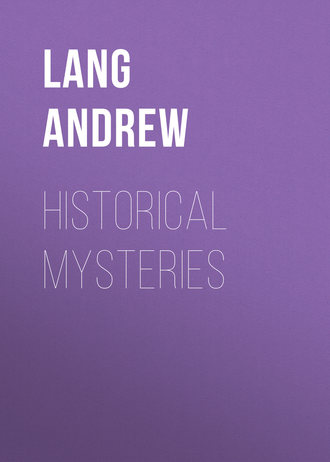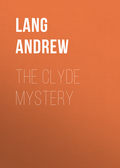
Lang Andrew
Historical Mysteries
X
QUEEN OGLETHORPE
(In collaboration with Miss Alice Shield)
'Her Oglethorpe majesty was kind, acute, resolute, and of good counsel. She gave the Prince much good advice that he was too weak to follow, and loved him with a fidelity which he returned with an ingratitude quite Royal.'
So writes Colonel Henry Esmond, describing that journey of his to Bar-le-Duc in Lorraine, whence he brought back 'Monsieur Baptiste,' all to win fair Beatrix Esmond. We know how 'Monsieur Baptiste' stole his lady-love from the glum Colonel, and ran after the maids, and drank too much wine, and came to the King's Arms at Kensington the day after the fair (he was always 'after the fair'), and found Argyll's regiment in occupation, and heard King George proclaimed.
Where in the world did Thackeray pick up the materials of that brilliant picture of James VIII., gay, witty, reckless, ready to fling away three crowns for a fine pair of eyes or a neat pair of ankles? His Majesty's enemies brought against him precisely the opposite kind of charges. There is a broad-sheet of 1716, Hue and Cry after the Pretender, which is either by Swift or by one of 'the gentlemen whom,' like Captain Bobadil, he 'had taught to write almost or altogether as well as himself.' As to gaiety in James, 'you tell him it is a fine day, and he weeps, and says he was unfortunate from his mother's womb.' As to ladies, 'a weakness for the sex remarked in many popular monarchs' (as Atterbury said to Lady Castlewood), our pamphleteer tells the opposite tale. Two Highland charmers being introduced 'to comfort him after the comfort of a man,' James displayed 'an incredible inhumanity to beauty and clean linen,' merely asking them 'whether they thought the Duke of Argyll would stand another battle?' It is hard on a man to be stamped by history as recklessly gay and amorous, also as a perfect Mrs. Gummidge for tearful sentiment, and culpably indifferent to the smiles of beauty. James is greatly misunderstood: the romance of his youth – sword and cloak and disguise, pistol, dagger and poison, prepared for him; story of true love blighted by a humorous cast of destiny; voyages, perils, shipwrecks, dances at inns – all is forgotten or is unknown.
Meanwhile, who was her 'Oglethorpean majesty,' and why does the pamphleteer of 1716 talk of 'James Stuart, alias Oglethorpe'? By a strange combination of his bad luck, James is called Miss Oglethorpe's ungrateful lover by Thackeray, and Miss Oglethorpe's brother by the pamphleteer, and by Whig slander in general. Thackeray, in fact, took Miss Oglethorpe from the letter which Bolingbroke wrote to Wyndham, after St. Germains found him out, as St. James's had done, for a traitor. Bolingbroke merely mentions Fanny Oglethorpe as a busy intriguer. There is no evidence that she ever was at Bar-le-Duc in her life, none that she ever was 'Queen Oglethorpe.' We propose to tell, for the first time, the real story of this lady and her sisters.
The story centres round The Meath Home for Incurables! This excellent institution occupies Westbrook Place, an old house at Godalming, close to the railway, which passes so close as to cut off one corner of the park, and of the malodorous tanyard between the remnant of grounds and the river Wey that once washed them. On an October day, the Surrey hills standing round about in shadowy distances, the silence of two centuries is scarcely broken by the rustle of leaves dropping on their own deep carpet, and the very spirit of a lost cause dwells here, slowly dying. The house stands backed by a steep wooded hill, beyond which corn-fields 'clothe the wold and meet the sky;' the mansion is a grey, two-storied parallelogram flanked by square towers of only slighter elevation; their projecting bays surmounted by open-work cornices of leafy tracery in whiter stone.
The tale used to run (one has heard it vaguely in conversation) that the old house at Godalming is haunted by the ghost of Prince Charlie, and one naturally asks, 'What is he doing there?' What he was doing there will appear later.
In 1688, the year of the Regifugium, Westbrook Place was sold to Theophilus Oglethorpe, who had helped to drive and, later, to rout Monmouth at Sedgemoor. This gentleman married Eleanor Wall, of an Irish family, a Catholic – 'a cunning devil,' says Swift. The pair had five sons and four daughters, about whom county histories and dictionaries of biography blunder in a helpless fashion. We are concerned with Anne Henrietta, born, probably, about 1680-83, Eleanor (1684), James (June 1, 1688, who died in infancy), and Frances Charlotte, Bolingbroke's 'Fanny Oglethorpe.' The youngest brother, James Edward, born 1696, became the famous philanthropist, General Oglethorpe, governor of Georgia, patron of the Wesleys, and, in extreme old age, the 'beau' of Hannah More, and the gentleman who remembered shooting snipe on the site of Conduit Street.
the Whigs
Frae Bothwell Brigs,
After the Revolution Sir Theophilus was engaged with Sir John Fenwick, was with him when he cocked his beaver in the face of the Princess of Orange, had to fly to France, after the failure at La Hogue, and in 1693 was allowed to settle peacefully at Westbrook Place. Anne and Eleanor were left in France, where they were brought up as Catholics at St. Germains, and befriended by the exiled James and Mary of Modena. Now in 1699 Theophilus, one of the Oglethorpe boys, was sent out to his father's old friend Mr. Pitt, Governor of Fort St. George in India, the man of the Pitt Diamond. His outfit had to be prepared in a hurry, and a young gentlewoman, Frances Shaftoe, was engaged to help with the sewing of his several dozens of linen shirts, 'the flourishing of neckcloths and drawing of cotton stripes;' as young gentlewomen of limited means were used to do before they discovered hospitals and journalism. This girl, who developed a political romance of her own, was of good Northumberland family, related to Sir John Fenwick and the Delavals. Her father, a merchant in Newcastle, had educated her 'in a civil and virtuous manner,' and she had lived there about eighteen years, behaving herself discreetly, modestly, and honestly, as nine Northumbrian justices of the peace were ready to testify under their hand. The strange story she later told of her experiences at Westbrook and afterwards cannot, therefore, be wholly dismissed as a tale trumped up for political purposes, though its most thrilling incident is so foolish a lie as to discredit the whole.
On the Saturday before Christmas 1699 (so ran her later 'revelations,'32 made in 1707) she took the coach from Godalming, obedient to instructions by letter from Sir Theophilus. A little way down the Strand he joined her in the coach, accompanied by two young ladies – friends, she was told, of Lady Oglethorpe; and for some time she knew no more of who they were and whence they came. They were very secret, appeared in no company, but made themselves useful in the pleasant, homely ways of English country life of that time: helped with the sewing, made their own bed, swept their chamber, dressed the two little girls, Mary and Fanny, and waited on each other. Presently it turned out that they were Anne and Eleanor Oglethorpe, who had been eleven years in France, at the Court of James II., where they were known as Anne and Eleanor Barkly. They had taken advantage of the peace to come secretly 'over a long sea,' and had waited at the house of their mother's brother-in-law, Mr. Cray the City wine-merchant, until Parliament was up and their father could take them home for Christmas. A member of Parliament must not be compromised by the presence of Catholic daughters from St. Germains, whom it was treason even to harbour.
Fanny Shaftoe was admitted into the family, she says, on quite familiar terms, but 'always behaved very meek and humble, ready to help any of the servants to make beds or to take care of the little boy' (the General) 'when his nurse was busy helping in the garden.' Anne and Eleanor were merry, friendly girls, and chatted only too freely with Fanny Shaftoe over the sewing. She certainly heard a great deal of 'treason' talked. She heard how Sir Theophilus and his wife went back and forward, disguised, between England and St. Germains; how Lady Oglethorpe had taken charge of the Queen's diamonds when she fled from Whitehall and safely returned them three years later, travelling as an old doctor-woman in a riding-hood, selling powders and plasters in a little basket. There was unseemly jubilation over the death of Queen Anne's son, the little Duke of Gloucester, in July 1700 – though Fanny admits they were sorry at first – and somewhat partisan comparisons were drawn between him, 'a poor, soft child who had no wit' (he was really a very promising, spirited boy), and the little Prince of Wales, 'who was very witty.'
To this careless chatter Fanny Shaftoe added exaggerations and backstairs gossip, and an astounding statement which lived as the feeblest lie can live. Anne Oglethorpe, she said, informed her that the real Prince of Wales (born June 10, 1688) had died at Windsor of convulsions when five or six weeks old; that Lady Oglethorpe hurried up to town with her little son James, born a few days before the Prince, and that the Oglethorpe baby died, or was lost on the road. The truth was a secret between her mother and the Queen! All they knew was that their little brother never turned up again. Anne added, confusing the story by too much detail, as all accounts of the royal fraud are confused, that the children had been sick together; that the Prince had then died, and her brother had been substituted for him.
In November 1700 Frances Shaftoe (according to her later revelations) left Westbrook: her mother had written from Newcastle to say her sister was dying. Anne and Eleanor were very sympathetic – they were really nice girls. Lady Oglethorpe was very kind, and gave her four guineas for her eleven months' services; and she seems to have been satisfied with it as handsome remuneration. She asserts, inconsistently, that she had much ado to get away; but she never went to Newcastle. Three months later, being still in London, she was sent for to a house in the Strand, where she met Anne Oglethorpe. Anne gave her a letter from her mother, which had been kept back because Anne had expected to come up sooner to town, otherwise she would have sent it. Anne had a cold and a swelled face. She and Eleanor were going to France, and she persuaded Fanny to go with them. To make a long tale short, they shut her up in a convent lest she should blab the great secret, 'James Stuart is really James Oglethorpe!'
In September 1701 James II. died, and Lady Oglethorpe carried to the Princess Anne the affecting letter of farewell he wrote to her, commending his family to her care. Anne and Eleanor went to England in November 1702, and from that date until Easter 1706 Fanny Shaftoe says she heard no more about them. In April 1702 Sir Theophilus died, and was buried in St. James's, Piccadilly, where the memorial erected by his widow may be seen.
Theophilus, the heir, probably remained a while in the far East with Pitt; but there were Oglethorpes nearer home to dabble in the Scots plot of that year (1704). In June several Scottish officers – Sir George Maxwell, Captain Livingstone, and others, amounting to fifteen or sixteen, with three ladies, one of whom was Anne Oglethorpe, embarked at the Hague for Scotland. Sir George had tried in vain to procure a passport from Queen Anne's envoy, so, though it was in war-time, they sailed without one. Harley informed by Captain Lacan, late of Galway's Foot in Piedmont, told Lord Treasurer Godolphin, who had the party arrested on landing. The Queen, who plotted as much as anybody on behalf of her brother, was indulgent to fellow-conspirators, and, though it was proved their purpose had been 'to raise commotions in Scotland,' they were soon set at liberty, and the informer sent back to Holland with empty pockets.33
Anne Oglethorpe, nevertheless, having crossed without a pass, lay at the mercy of the Government, but, as with Joseph in Egypt, her misfortune turned into her great opportunity. The late Mr. H. Manners, in an article in the Dictionary of National Biography,34 supposes she had been King James's mistress before she left St. Germains. Now, see how Thackeray has misled historians! He makes Fanny Oglethorpe, James's mistress, 'Queen Oglethorpe,' at Bar-le-Duc in 1714. And, resting on this evidence, Mr. Manners represents Anne Oglethorpe as James's mistress at St. Germains in 1704! Anne left St. Germains before James was sixteen, and her character is blasted by the easy plan of mistaking her for her younger sister, who was no more Queen Oglethorpe than she was.
Poor Anne did not 'scape calumny, perhaps deserved it. Boyer says that Godolphin and Harley quarrelled for her smiles, which beamed on Harley (Lord Oxford, Swift's 'Dragon'), and 'an irreconcilable enmity' arose. In 1713 Schutz describes Anne Oglethorpe as Oxford's mistress, but she had troubles of her own before that date. She arrived in England, a Jacobite conspirator, in 1704. Her wit and beauty endeared her to Harley, and she probably had a foot in both camps, Queen Anne's and King James's.
But in 1706 strange rumours came from the North. Mrs. Shaftoe had, after five years' silence, received letters from her daughter Fanny, the sempstress, by a secret hand, and was filling Newcastle with lamentations over trepanning, imprisonment, and compulsory conversion, with the object of making Fanny a nun. A young English priest, agent for supplying the Catholic squires of Northumberland with chaplains, was sent to France by her Catholic cousin, Mrs. Delaval, to find out the truth. The consequence of his inquiries was that Anne Oglethorpe was arrested in England, and charged before the Queen and Council with trepanning and trying to force Fanny Shaftoe to become a nun. Anne flung herself at the Queen's feet and implored mercy. She escaped being sent to Newgate, but was imprisoned in a Messenger's house to await further proceedings, and ordered to produce Fanny Shaftoe as a witness.
Eleanor Oglethorpe was in France, and rushed to the convent where Fanny Shaftoe was held captive, told her how Anne was in prison on her account, and entreated her to sign a statement that she had come to France and become a Catholic of her own free will. But Fanny refused. Her long detailed story was printed and published for the prosecution in 1707, at the moment when the Chevalier's chances in Scotland were most promising. Had he landed only with his valet, says Ker of Kersland, Scotland would have been his. Cameronians and Cavaliers alike would have risen. But the French Admiral would not put him on shore. As for Anne she was discharged, having great allies; but Fanny Shaftoe's story did its work. James Stuart, for Whig purposes, was 'James Oglethorpe,' Anne's brother. Fanny's narrative was republished in 1745, to injure Prince Charlie.
Restored to society and Harley, Anne queened it royally. If we believe old Tom Hearne, whose MSS. are in the Bodleian, Anne practically negotiated the Treaty of Utrecht. She found a French priest, whose sister was in the household of Madame de Maintenon, she wrote mysterious letters to him, he showed them to Louis XIV., and the priest was presently lurking in Miss Oglethorpe's town house. Harley visited his Egeria; she introduced the abbé; Gauthier (the abbé himself?) and Messager were appointed by France to treat. Harley insisted on the surrender of Dunkirk! Louis offered Anne Oglethorpe 2,000,000 livres if she would save Dunkirk for France. Her Oglethorpean majesty refused the gold, but did Louis's turn, on condition that he would restore King James! For all this magnanimity we have only Tom Hearne's word. Swift, for example, was not likely to reveal these romantic circumstances about the Lady and the Dragon.
Swift does not mention Anne in his letters, but being so deep in the greatest intrigues of the day and in the smallest, she was a valuable source of information to Thomas Carte, the nonjuring historian and her lifelong correspondent, when he was gathering materials for his Life of the first Duke of Ormond and his History of England. In 1713, Nairne, James's secretary, desires Abram (Menzies) to inquire if Mrs. Oglethorpe had credit with Honyton (Harley), and how far?35 Schutz, the Hanoverian envoy, writes to Bothmar, November 21, 1713: 'Miss Oglethorpe, the Lord Treasurer's mistress, said that the Pretender was to travel, and she said it on the very day the news came from Holland that the Bishop of London had declared to the plenipotentiaries who are there, that the Queen entreated their masters not to receive the Pretender in their dominions.'36 She knew all the particulars of Harley's opposition to the Duke of Ormond's schemes for improving the army, and what the Exchequer could and could not supply to back them.37 She knew all about Lady Masham's quarrel with her cousin, Lord Oxford, in 1713, over the 100,000l. in ten per cents which Lady Masham had expected to make out of the Quebec expedition and Assiento contract, had not his lordship so 'disobliged her.' Anne acted as intermediary, hunting up her friend the Duke of Ormond, with whom her mother had great influence, and fetching him to meet Lady Masham at Kensington – who told him how ill the Queen was, and how uneasy at nothing being done for her brother, the Chevalier. If Ormond would but secure Lady Masham 30,000l. of the 100,000l., she would join with him, and he should have the modelling of the army as he pleased. Ormond also failed to oblige Lady Masham, but Bolingbroke, whom she hated, snatched his opportunity in the quarrel and got her the money; in return for which service, Lady Masham had Harley turned out of office and Bolingbroke set in his place. And then Queen Anne died.
Miss Oglethorpe also knew that Sir Thomas Hanmer and Bishop Atterbury were the two persons who sent the messenger (mentioned only as Sir C.P. in the Carte Papers) to warn Ormond to escape to France in 1715. Women seem to have managed the whole political machine in those days, as the lengthy and mysterious letters of 'Mrs. White,' 'Jean Murray,' and others in the Carte MSS. testify.
We are not much concerned with the brothers of the Oglethorpe girls, but the oldest, Theophilus, turned Jacobite. That he had transferred his allegiance and active service to King James is proved by his letters from Paris to James, and to Gualterio in 1720 and 1721.38 According to the second report on the Stuart Papers at Windsor, he was created a baron by James III in 1717. In 1718 he was certainly outlawed, for his younger brother, James Edward (the famous General Oglethorpe), succeeded to the Westbrook property in that year.
In July 1714 Fanny Oglethorpe, now about nineteen, turns up as an active politician. The Chevalier at Bar and his adherents in Paris, Scotland, and London, were breathlessly waiting for the death of Queen Anne, which was expected to restore him to the throne of his ancestors. Fanny had been brought up a Protestant by her mother in England, under whose auspices she had served her apprenticeship to plotting. Then she came to France, but Fanny cannot have been Thackeray's 'Queen Oglethorpe' at Bar-le-Duc. In the first place, she was not there; in the second, a lady of Lorraine was reigning monarch.39
With the fall of Oxford in 1714 ended Anne's chief opportunity of serving her King. The historian therefore turns to her sister Eleanor, who had been with her in the Fanny Shaftoe affair, but remained in France. Penniless as she was, Eleanor's beauty won the heart of the Marquis de Mézières, a great noble, a man over fifty, ugly, brave, misshapen. Theirs, none the less, was a love match, as the French Court admiringly proclaimed. 'The frog-faced' Marquis, the vainest of men, was one of the most courageous. Their daughters became the Princesses de Montauban and de Ligne, whose brilliant marriages caused much envy. Of their sons we shall hear later. Young Fanny Oglethorpe, a girl of twenty in 1715, resided with her sister Eleanor (Madame de Mézières), and now Bolingbroke, flying from the Tower, and become the Minister of James, grumbles at the presence of Fanny, and of Olive Trant, among the conspirators for a Restoration. Olive, the Regent's mistress, was 'the great wheel of the machine,' in which Fanny 'had her corner,' at Saint Germains. 'Your female teazers,' James calls them in a letter to Bolingbroke. Not a word is said of a love affair.
How the Fifteen ended we all know. Ill-managed by Mar, perhaps betrayed by Bolingbroke, the rising collapsed. Returning to France, James dismissed Bolingbroke and retired to Avignon, thence to Urbino, and last to Rome. In 1719 he describes 'Mrs. Oglethorpe's letters' as politically valueless, and full of self-justifications, and 'old stories.' He answers them only through his secretary; but in 1722 he consoled poor Anne by making her a Countess of Ireland. Anne's bolt was shot, she had had her day, but the day of her fair sisters was dawning. Mr. John Law, of Lauriston soi-disant, had made England too hot to hold him. His great genius for financial combinations was at this time employed by him in gleek, trick-track, quadrille, whist, loo, ombre, and other pastimes of mingled luck and skill. In consequence of a quarrel about a lady, Mr. Law fought and slew Beau Wilson, that mysterious person, who, from being a poverty-stricken younger son, hanging loose on town, became in a day, no man knows how, the richest and most splendid of blades. The Beau's secret died with him; but Law fled to France with 100,000 crowns in his valise. Here the swagger, courage, and undeniable genius of Mr. Law gained the favour of the Regent d'Orléans, the Bank and the Mississippi Scheme were floated, the Rue Quincampoix was crowded, France swam in a dream of gold, and the friends of Mr. Law, 'coming in on the ground-floor,' or buying stock before issue at the lowest prices, sold out at the top of the market.
Paris was full of Jacobites from Ireland and Scotland – Seaforth, Tullibardine, Campbell of Glendaruel, George Kelly (one of the Seven Men of Moidart), Nick Wogan, gayest and bravest of Irishmen, all engaged in a pleasing plan for invading England with a handful of Irish soldiers in Spanish service. The Earl Marischal and Keith his brother (the Field-Marshal) came into Paris broken men, fleeing from Glenshiel. They took no Mississippi shares, but George Kelly, Fanny Oglethorpe, and Olive Trant, all liés with Law and Orléans, 'plunged,' and emerged with burdens of gold. Fanny for her share had 800,000 livres, and carried it as her dowry to the Marquis des Marches, whom she married in 1719, and so ceased conspiring. The Oglethorpe girls, for penniless exiles, had played their cards well. Fanny and Eleanor had won noble husbands. Poor Anne went back to Godalming, where – in the very darkest days of the Jacobite party, when James was a heart-broken widower, and the star of Prince Charles's natal day shone only on the siege of Gaeta – she plotted with Thomas Carte, the historian.
The race of 1715 was passing, the race of 1745 was coming on, and touching it is to read in the brown old letters the same loyal names – Floyds, Wogans, Gorings, Trants, Dillons, Staffords, Sheridans, the Scots of course, and the French descendants of the Oglethorpe girls. Eleanor's infants, the de Mézières family, had been growing up in beauty and honour, as was to be expected of the children of the valiant Marquis and the charming Eleanor. Their eldest daughter, Eléonore Eugénie, married Charles de Rohan, Prince de Montauban, younger brother of the Duc de Montbazon, whose wife was the daughter of the Duc de Bouillon and Princess Caroline Sobieska, and so first cousin to the sons of James III. That branch of Oglethorpes thus became connected with the royal family, which would go far towards rousing their hereditary Jacobitism when the Forty-Five cast its shadow before.
In May 1740, Madame de Mézières took it into her head to run over to England, and applied to Newcastle for a pass, through Lady Mary Herbert of Powis – a very suspect channel! The Minister made such particular inquiries as to the names of the servants she intended to bring, that she changed her mind and did not go. One wonders what person purposed travelling in her suite whose identity dared not stand too close scrutiny. There was a brave and eager Prince of Wales over the water, nearly twenty, who had some years ago fleshed his maiden sword with honour, and who was in secret correspondence on his own account with his father's English supporters. Could he have had some such plan even then of putting fate to the touch? He is reported in Coxe's Walpole to have been in Spain, in disguise, years before.
In 1742 Eleanor had the sorrow of losing a daughter in a tragic way. She had recently become a canoness of Povesay, a very noble foundation, indeed, in Lorraine, where the Sisters wore little black ribbons on their heads which they called 'husbands.' She was twenty-five, very pretty, and most irreligiously devoted to shooting and hunting. Though these chapters of noble canonesses are not by any means strict after the use of ordinary convents, there were serious expostulations made when the novice insisted upon constantly carrying a gun and shooting. She fell one day when out with her gun as usual. It went off and killed her on the spot.
Whatever Eleanor aimed at in 1740 by a journey to England, was baulked by Newcastle's caution. In 1743 the indefatigable lady, 'and a Scottish lord,' submitted a scheme to Louis XV., but it was thwarted by de Noailles. Then Prince Charles rode secretly out of Rome, landed, like Napoleon, at Fréjus, and at the expedition of Dunkirk met the Earl Marischal and young Glengarry.
The Chevalier de Mézières, too, Eleanor's son, went to Dunkirk with Saxe to embark for England. There was a great storm, and the ships went aground. Several officers and soldiers jumped into the sea, and some were drowned. The Chevalier de Mézières came riding along the shore, to hear that a dear friend was drowning. The sea was going back, but very heavy, and de Mézières rode straight into the raging waters to seek his friend. The waves went over his head and carried away his hat, but he persevered until he had seized a man. He dragged him ashore, to find it was a common soldier. He hastened back, and saved several soldiers and two or three officers. His friend, after all, had never been in danger.
The Saxe expedition never sailed, so Eugène de Mézières went to beat Hanoverians elsewhere, and was wounded at Fontenoy. Consequently he could not follow the Prince to Scotland. His mother, Eleanor, plunged into intrigue for the forward party (Prince Charlie's party), distrusted by James at Rome. 'She is a mad woman,' said James. She and Carte, the historian, were working up an English rising to join the Prince's Scottish adventure, but were baffled by James's cautious, helpless advisers. Then came the Forty-Five. Eleanor was not subdued by Culloden: the undefeated old lady was a guest at the great dinner, with the splendid new service of plate, which the Prince gave to the Princesse de Talmond and his friends in 1748. He was braving all Europe, in his hopeless way, and refusing to leave France, in accordance with the Treaty of Aix-la-Chapelle. When he was imprisoned at Vincennes, Eleanor was threatened. Catholic as she was, she frankly declared that Prince Charles had better declare himself a Protestant, and marry a German Protestant Princess. He therefore proposed to one, a day or two before he disappeared from Avignon, in February 1749, and he later went over to London, and embraced the Anglican faith.
It was too late; but Eleanor Oglethorpe was not beaten. In October 1752 'the great affair' was being incubated again. Alexander Murray, of the Elibank family, exasperated by his imprisonment for a riot at the Westminster election, had taken service with Prince Charles. He had arranged that a body of young Jacobite officers in foreign service, with four hundred Highlanders under young Glengarry, should overpower the Guards, break into St. James's Palace, and seize King George; while the Westminster mob, Murray's lambs, should create an uproar. Next day Glengarry would post north, the Highlanders would muster at the House of Touch, and Charles would appear among his beloved subjects. The very medal to commemorate the event was struck, with its motto, Laetamini Cives. The Prince was on the coast in readiness – nay, if we are not mistaken, the Prince was in Westbrook House at Godalming!
This we conjecture because, in that very budding time of the Elibank Plot, Newcastle suddenly discovered that the unwearied Eleanor Oglethorpe, Marquise de Mézières, was in England, – had arrived secretly, without any passport. He tracked her down at Westbrook House, that lay all desolate and deserted, the windows closed, the right-of-way through the grounds illegally shut up. General Oglethorpe after 1746 had abandoned his home, for he had been court-martialled on a charge of not attacking Cluny and Lord George Murray, when the Highlanders stood at bay, at Clifton, and defeated Cumberland's advanced-guard. The general was acquitted, but, retiring to his wife's house at Carham, he deserted Westbrook Place.
The empty house, retired in its woodlands, on the Portsmouth road, convenient for the coast, was the very place for Prince Charles to lurk in, while Murray and Glengarry cleared the way to the throne. And so, in fact, we find Eleanor Oglethorpe secretly ensconced at Westbrook Place while the plot ripened, and local tradition still shows the vault in which 'the Pretender' could take refuge if the house was searched. All this, again, coincides with the vague legend of the tall, brown-haired ghost who haunts Westbrook Place, – last home of a last hope.







